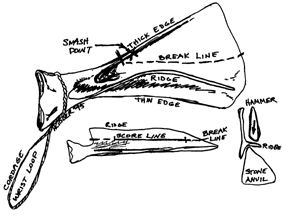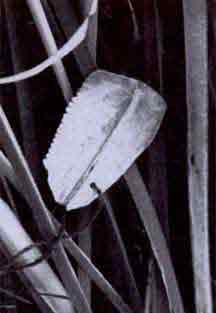
Over the years, my job has involved me in efforts to bring a local stone-age culture into the reality of 21st Century youth and adults. Letting people see, feel and use the tools from this time has proven the single most affective teaching technique. The first of these efforts at replication involved a common tool type at our sites called, by archaeologists, a scapular saw. The scapula is more simply known as the shoulder blade, in this case from a deer, elk or antelope. It has been modified to expose a thin area, which is notched to produce a saw-like cutting edge. The first saws were made using power tools, but looked like such. Tools made using hacksaws and files were better, but not yet authentic looking, and gave no information on efficient manufacturing techniques. They did however allow us to test the tools for possible uses. Archaeologists did not list their uses, since that would be speculation, but trying them on wood, meat, grass, weeds, tules and cattails; as hair combs, fish scalers and everything else we could think of left one easy conclusion. The only thing they cut really well is tules and other soft plants, and they cut them more efficiently than any other known tool from that area. The wear and polish patterns on the artifacts also match the replicas. The fact that local Indians built their houses, boats, mats, duck decoys and beds out of tules makes for overwhelming logic for calling them tule saws.

The final step in this Level II effort (see Callahan in the Primitive Technology Newsletter, Summer '95) was to find the most efficient way to make the tool with the kit available to our ancient craftsmen. The tasks to be performed included: removal of unwanted bone; smoothing of modified surfaces;and filing notches in the cutting edge. The tool kit that was known from the digs included many unmodified flakes of chert and quartzite, and various pieces of fine hard sandstone, much of it fire broken. There were relatively few specialized tools. The specific steps involved removing a fin-like ridge from one surface of the bone, and a triangular shaped section of the main piece (see illustrations). Initially I worked at removing these sections by scoring or engraving lines at the desired break points using burin-like edges on the unmodified chert flakes. This was tedious work, and did not always guarantee that the bone would break as planned. Attempting to make a saw as quickly as possible, I abandoned the engraving step and went to crude bashing with hammer stones. After breaking a few in half, I found that I could use a carefully selected anvil stone, and break the bone a safe distance from the final shape, then grind and 'nibble' it to shape. This took much less time and effort, and produced a replica that compared favorably to the originals. If the bone is fresh and soft, engraving in a few problem spots can help avoid disasters. Once shaped, all rough surfaces were smoothed on a sandstone abrader.
The final notching step took similar experimentation until
I settled on using any thin, abrasive stone edge from hard quartzite
to soft sandstone to file at a fairly flat angle on each side.
This last step took the most time, about 20 minutes. Using these
methods it now takes 30 to 40 minutes to make a finished tool
that will last for years of cutting tules. Over time, teeth break,
but can be refiled, giving the tool a more scythe-like appearance
found in many of the old specimens.

When demonstrating tule crafts, the saw is perfect as it demonstrates an authentic tool, and is also the best tool bar none at splitting tule stems, as it tears rather than cuts (also a good safety feature when working with kids).
When making the tool, it also demonstrates the importance of unmodified 'found' tools, which are rarely collected by archaeologists or displayed in museums, but which did much of the work in prehistory.
This article was first published in The
Bulletin of Primitive Technology (Fall 1995, #10)
E-mail your comments to "Norm Kidder " at atlatl1@aol.com
We hope the information on the PrimitiveWays website is both instructional and enjoyable. Understand that no warranty or guarantee is included. We expect adults to act responsibly and children to be supervised by a responsible adult. If you use the information on this site to create your own projects or if you try techniques described on PrimitiveWays, behave in accordance with applicable laws, and think about the sustainability of natural resources. Using tools or techniques described on PrimitiveWays can be dangerous with exposure to heavy, sharp or pointed objects, fire, stone tools and hazards present in outdoor settings. Without proper care and caution, or if done incorrectly, there is a risk of property damage, personal injury or even death. So, be advised: Anyone using any information provided on the PrimitiveWays website assumes responsibility for using proper care and caution to protect property, the life, health and safety of himself or herself and all others. He or she expressly assumes all risk of harm or damage to all persons or property proximately caused by the use of this information.
© PrimitiveWays 2013